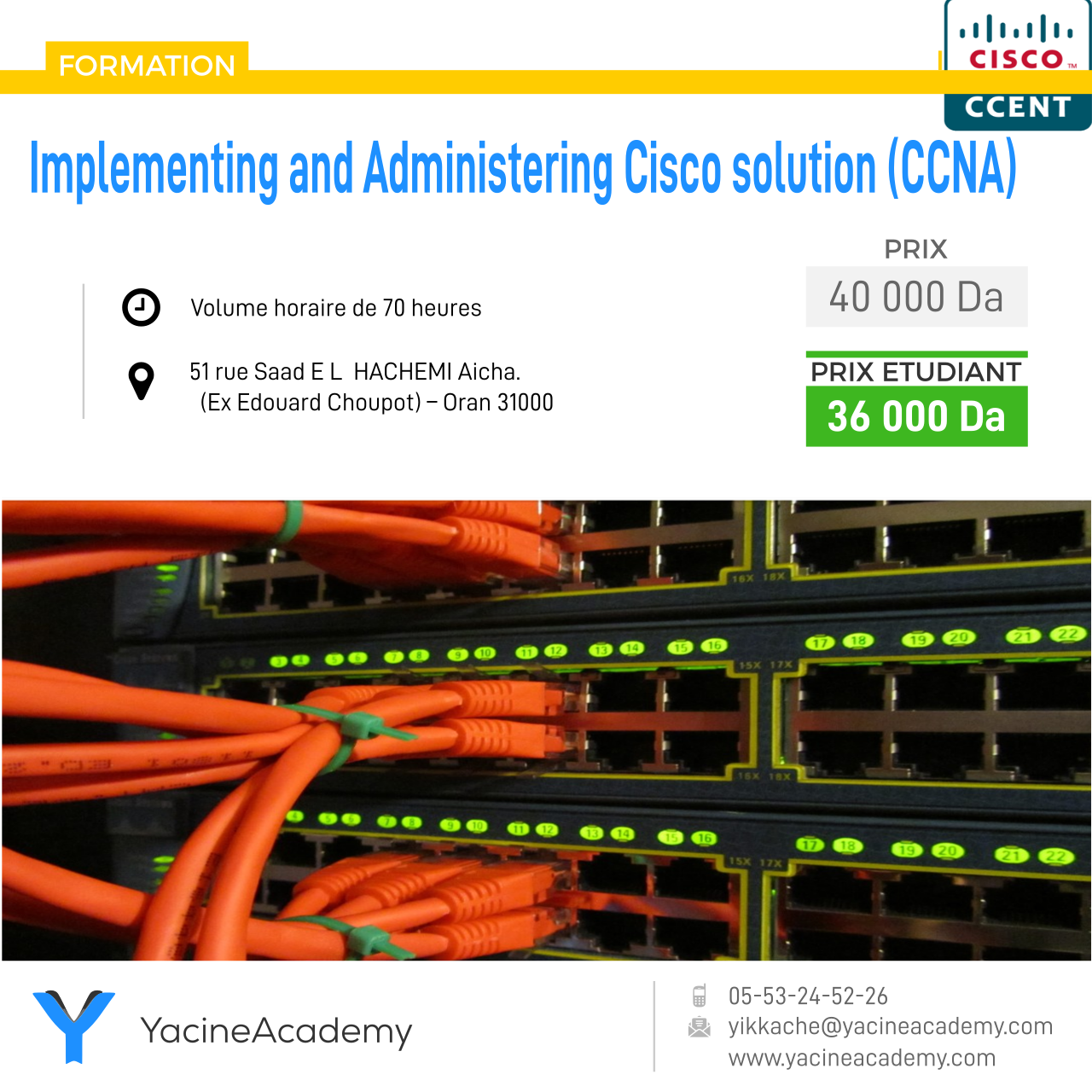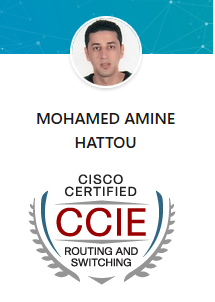





Cette formation permet d’acquérir les connaissances et compétences nécessaires pour installer, faire fonctionner, configurer et vérifier les réseaux IPv4 et IPv6, y compris la configuration des commutateurs LAN, les Access point WLAN et les Routeurs ainsi que l’identification des menaces contre la sécurité et comment remédier en plus de ca on apprend le Nouveau paradigme de réseau « l’automatisation et la programmabilité »
Apprendre les sujets ci-dessous :
Fondamentaux du réseau
L'accès au réseau
Connectivité IP
Services IP
Fondamentaux de la sécurité
Automatisation et programmabilité
.

Yacine IKKACHE est un enseignant chercheur a l’Institut National des Télécommunication et des TIC , il poursuit ses études doctoral sur la reconnaissance de la parole Arabe dans un environnement mobile. Il a eu un BAC en Sciences exactes puis il a poursuivit ces études en tronc commun technologies a l'USTO pour enfin rejoindre l'INTTIC ou il a eu l'ingéniorat en télécoms, puis le magister en TIC
Les compétences de Mr Yacine ne se limitent pas au monde académique et théorique, dés qu'il a terminé sa formation d'ingénieur il s'est penché vers le monde professionnel où il a travaillé dans plusieurs sociétés tel que UMOIP, SONATRACH, SLC et ISSAL ou il a acquis de l’expérience dans plusieurs disciplines, on cite parmi-eux VOIP, SCADA, OTN, WIMAX, ADSL, CLOUD COMPUTING....etc. Il a aussi plusieurs certifications professionnelles de différents constructeurs comme CISCO et JUNIPER, IPBrick
Grace a son double profile (académique et professionnel) il a constaté qu’il y’a un écart entre les deux mondes ; d’où vient l’idée de créer YacineAcademy dans le but de construire une passerelle qui relie le monde académique et professionnel

Amine is a Networking expert he has more then 10 years experiance in ISP Core Network ; he hold serveral Certfications from different Network equipement vendor ; the valuable one is CCIE "Cisco Certified Internetwork Expert".
other cisco certificates :
CCNP RS ; CCNP SP ; CCNA RS/SEC/SP
Cisco certified academy instructor CCAI
Cisco instructor trainer (ITQ)
Juniper certificates:
JNCIA ; JNCIS-ENT, JNCIP-ENT, JNCIS-SP; JNCIP-SP
|
Network Fundamentals |
||
|
1.1 Explain the role and function of network components · 1.1.a Routers · 1.1.b L2 and L3 switches · 1.1.c Next-generation firewalls and IPS · 1.1.d Access points · 1.1.e Controllers (Cisco DNA Center and WLC) · 1.1.f Endpoints · 1.1.g Servers 1.2 Describe characteristics of network topology architectures · 1.2.a 2 tier · 1.2.b 3 tier · 1.2.c Spine-leaf · 1.2.d WAN · 1.2.e Small office/home office (SOHO) · 1.2.f On-premises and cloud 1.3 Compare physical interface and cabling types · 1.3.a Single-mode fiber, multimode fiber, copper · 1.3.b Connections (Ethernet shared media and point-to-point) · 1.3.c Concepts of PoE 1.4 Identify interface and cable issues (collisions, errors, mismatch duplex, and/or speed) 1.5 Compare TCP to UDP 1.6 Configure and verify IPv4 addressing and subnetting 1.7 Describe the need for private IPv4 addressing 1.8 Configure and verify IPv6 addressing and prefix 1.9 Compare IPv6 address types · 1.9.a Global unicast · 1.9.b Unique local · 1.9.c Link local · 1.9.d Anycast · 1.9.e Multicast · 1.9.f Modified EUI 64 1.10 Verify IP parameters for Client OS (Windows, Mac OS, Linux) 1.11 Describe wireless principles · 1.11.a Nonoverlapping Wi-Fi channels · 1.11.b SSID · 1.11.c RF · 1.11.d Encryption 1.12 Explain virtualization fundamentals (virtual machines) 1.13 Describe switching concepts · 1.13.a MAC learning and aging · 1.13.b Frame switching · 1.13.c Frame flooding · 1.13.d MAC address table |
||
|
2.0 Network Access |
||
|
2.1 Configure and verify VLANs (normal range) spanning multiple switches · 2.1.a Access ports (data and voice) · 2.1.b Default VLAN · 2.1.c Connectivity 2.2 Configure and verify interswitch connectivity · 2.2.a Trunk ports · 2.2.b 802.1Q · 2.2.c Native VLAN 2.3 Configure and verify Layer 2 discovery protocols (Cisco Discovery Protocol and LLDP) 2.4 Configure and verify (Layer 2/Layer 3) EtherChannel (LACP) 2.5 Describe the need for and basic operations of Rapid PVST+ Spanning Tree Protocol and identify basic operations · 2.5.a Root port, root bridge (primary/secondary), and other port names · 2.5.b Port states (forwarding/blocking) · 2.5.c PortFast benefits 2.6 Compare Cisco Wireless Architectures and AP modes 2.7 Describe physical infrastructure connections of WLAN components (AP,WLC, access/trunk ports, and LAG) 2.8 Describe AP and WLC management access connections (Telnet, SSH, HTTP,HTTPS, console, and TACACS+/RADIUS) 2.9 Configure the components of a wireless LAN access for client connectivity using GUI only such as WLAN creation, security settings, QoS profiles, and advanced WLAN settings |
||
|
3.0 IP Connectivity |
||
|
3.1 Interpret the components of routing table · 3.1.a Routing protocol code · 3.1.b Prefix · 3.1.c Network mask · 3.1.d Next hop · 3.1.e Administrative distance · 3.1.f Metric · 3.1.g Gateway of last resort 3.2 Determine how a router makes a forwarding decision by default · 3.2.a Longest match · 3.2.b Administrative distance · 3.2.c Routing protocol metric 3.3 Configure and verify IPv4 and IPv6 static routing · 3.3.a Default route · 3.3.b Network route · 3.3.c Host route · 3.3.d Floating static 3.4 Configure and verify single area OSPFv2 · 3.4.a Neighbor adjacencies · 3.4.b Point-to-point · 3.4.c Broadcast (DR/BDR selection) · 3.4.d Router ID 3.5 Describe the purpose of first hop redundancy protocol |
||
|
4.0 IP Services |
||
|
4.1 Configure and verify inside source NAT using static and pools 4.2 Configure and verify NTP operating in a client and server mode 4.3 Explain the role of DHCP and DNS within the network 4.4 Explain the function of SNMP in network operations 4.5 Describe the use of syslog features including facilities and levels 4.6 Configure and verify DHCP client and relay 4.7 Explain the forwarding per-hop behavior (PHB) for QoS such as classification, marking, queuing, congestion, policing, shaping 4.8 Configure network devices for remote access using SSH 4.9 Describe the capabilities and function of TFTP/FTP in the network |
||
|
5.0 Security Fundamentals |
||
|
5.1 Define key security concepts (threats, vulnerabilities, exploits, and mitigation techniques) 5.2 Describe security program elements (user awareness, training, and physical access control) 5.3 Configure device access control using local passwords 5.4 Describe security password policies elements, such as management, complexity, and password alternatives (multifactor authentication, certificates, and biometrics) 5.5 Describe remote access and site-to-site VPNs 5.6 Configure and verify access control lists 5.7 Configure Layer 2 security features (DHCP snooping, dynamic ARP inspection, and port security) 5.8 Differentiate authentication, authorization, and accounting concepts 5.9 Describe wireless security protocols (WPA, WPA2, and WPA3) 5.10 Configure WLAN using WPA2 PSK using the GUI |
||
|
6.0 Automation and Programmability |
||
|
6.1 Explain how automation impacts network management 6.2 Compare traditional networks with controller-based networking 6.3 Describe controller-based and software defined architectures (overlay, underlay, and fabric) · 6.3.a Separation of control plane and data plane · 6.3.b North-bound and south-bound APIs 6.4 Compare traditional campus device management with Cisco DNA Center enabled device management 6.5 Describe characteristics of REST-based APIs (CRUD, HTTP verbs, and data encoding) 6.6 Recognize the capabilities of configuration management mechanisms Puppet, Chef, and Ansible 6.7 Interpret JSON encoded data |
||